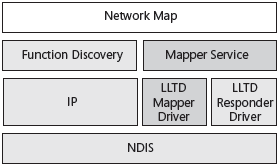How Windows Creates the Network Map
Windows creates the Network Map in part by using the Link Layer Topology Discovery (LLTD) protocol. As the name suggests, LLTD functions at Layer 2 (the layer devices use to communicate on a LAN) and enables network devices to identify each other, learn about the network (including bandwidth capabilities), and establish communications (even if devices are not yet configured with IP addresses). Typically, you do not need to manage LLTD directly. However, you can configure two Group Policy settings located within Computer Configuration\Policies\Administrative Templates\Network \Link Layer Topology Discovery:
- Turn on Responder (RSPNDR) Driver This setting enables computers to be discovered on a network and to participate in Quality of Service (QoS) activities, such as bandwidth estimation and network health analysis. You can choose to enable the responder driver while connected to networks of the domain, public, or private location type. Windows enables the responder driver for all networks by default.
- Turn on Mapper I/O (LLTDIO) Driver This setting enables a computer to discover the topology of the local network and to initiate QoS requests. You can choose to enable the mapper driver while connected to networks of the domain, public, or private location type. This option is enabled for all networks by default. Windows enables the mapper driver for all networks by default.
Figure below illustrates how the LLTD responder and mapper relate to other networking components.

Note Windows Vista and Windows 7 include an LLTD responder, but earlier versions of Windows do not. To find out how to download an LLTD responder that you can add to Windows XP, read Microsoft Knowledge Base article 992120 at http://support.microsoft.com/kb/922120. This will enable computers running Windows XP to appear on the Network Maps in Windows 7, but they still cannot generate the maps.
LLTD is not a secure protocol, and there is no guarantee that the Network Map is accurate. It is possible for devices on the network to send false announcements, adding bogus items to the map.
Because each user can have his own set of network profiles, Windows creates Network Maps on a per-user basis. For each network profile that a user creates, Windows actually generates two maps: the current map and a copy of the last functional map (similar to the Last Known Good recovery option). When displaying the Network Map to the user, Windows combines these two maps.
In this tutorial:
- Configuring Windows Networking
- Usability Improvements
- Network And Sharing Center
- Network Explorer
- How Windows Finds Network Resources
- How Windows Publishes Network Resources
- How Windows Creates the Network Map
- Network Map
- Set Up A Connection Or Network Wizard
- Manageability Improvements
- Network Location Types
- Policy-Based QoS
- Selecting DSCP Values
- Planning Traffic Throttling
- Configuring QoS Policies
- Configuring System-Wide QoS Settings
- Configuring Advanced QoS Settings
- Testing QoS
- Windows Firewall and IPsec
- Windows Connect Now in Windows 7
- Core Networking Improvements
- Networking BranchCache
- How Hosted Cache Works
- How Distributed Cache Works
- Configuring BranchCache
- BranchCache Protocols
- File Sharing Using SMB
- Web Browsing with HTTP (Including HTTPS)
- DNSsec
- GreenIT
- Efficient Networking
- What Causes Latency, How to Measure It, and How to Control It
- TCP Receive Window Scaling
- Scalable Networking
- Improved Reliability
- IPv6 Support
- 802.1X Network Authentication
- Server Message Block (SMB) 2.0
- Strong Host Model
- Wireless Networking
- Improved APIs
- Network Awareness
- Improved Peer Networking
- Services Used by Peer-to-Peer Networking
- Managing Peer-to-Peer Networking
- Peer-to-Peer Name Resolution
- EAP Host Architecture
- Layered Service Provider (LSP)
- Windows Sockets Direct Path for System Area Networks
- How to Configure Wireless Settings
- Configuring Wireless Settings Manually
- Using Group Policy to Configure Wireless Settings
- How to Configure TCP/IP
- DHCP
- Configuring IP Addresses Manually
- Command Line and Scripts
- How to Connect to AD DS Domains
- How to Connect to a Domain When 802.1X Authentication Is Not Enabled
- How to Connect to a Domain When 802.1X Authentication Is Enabled
